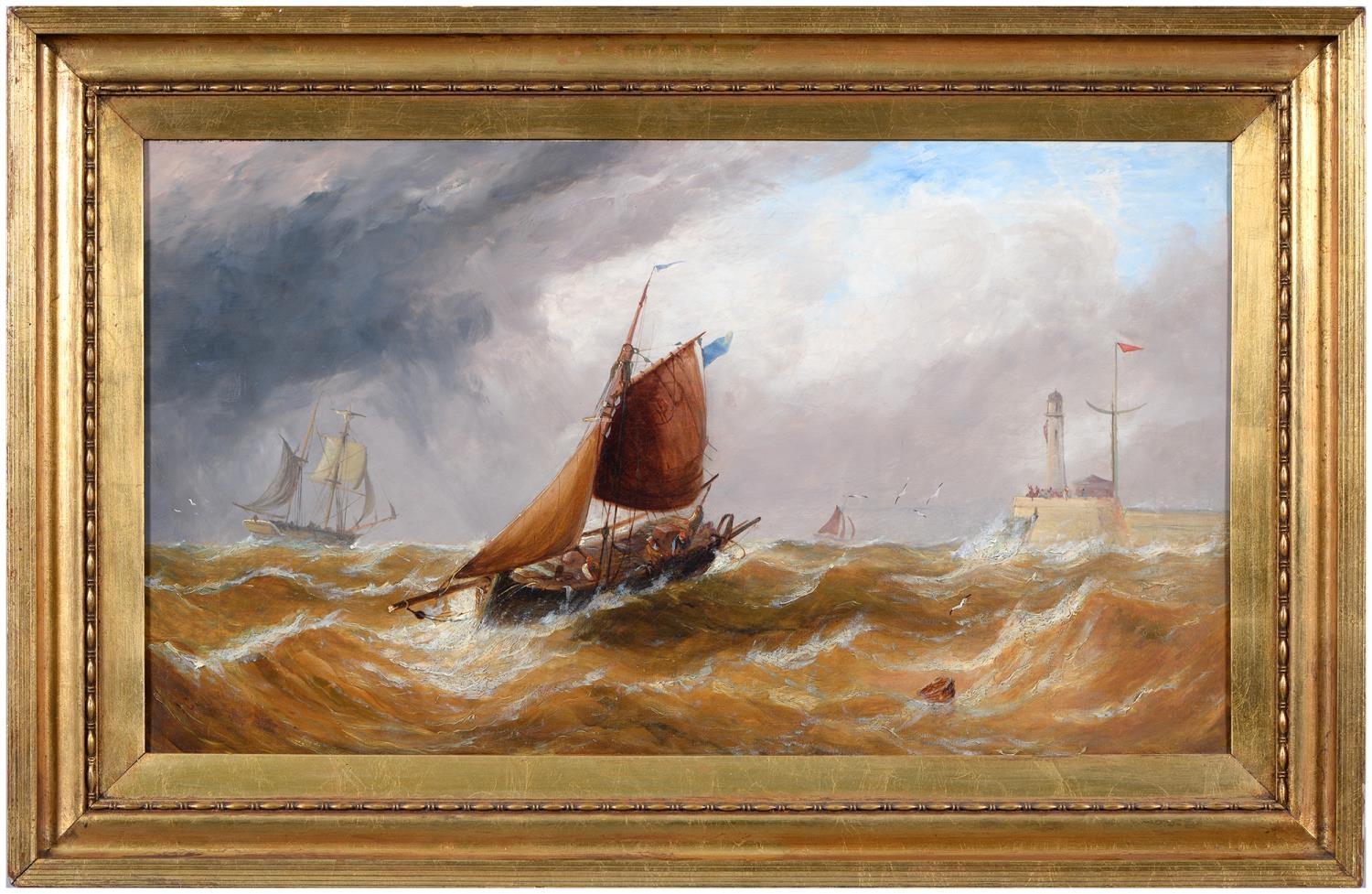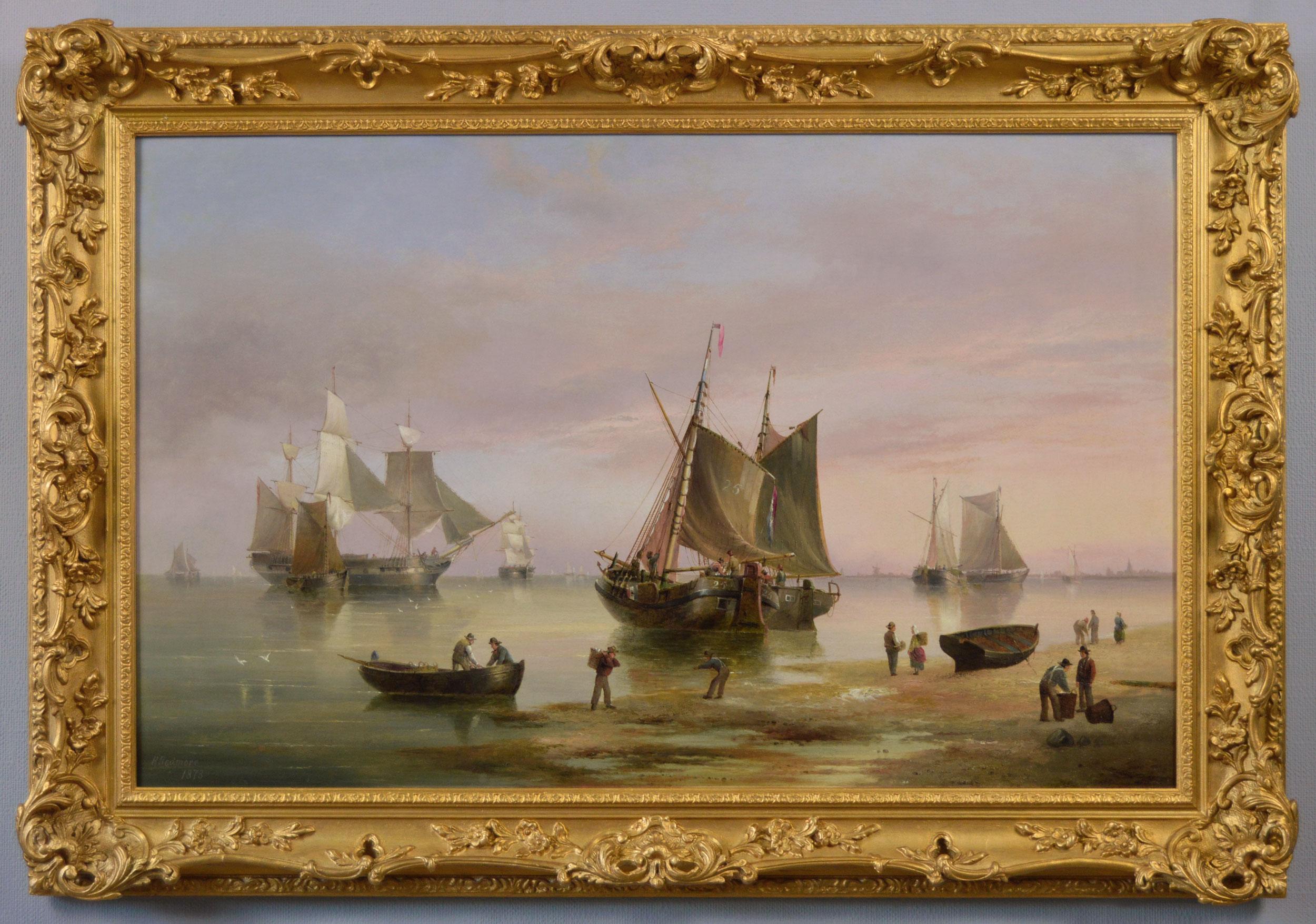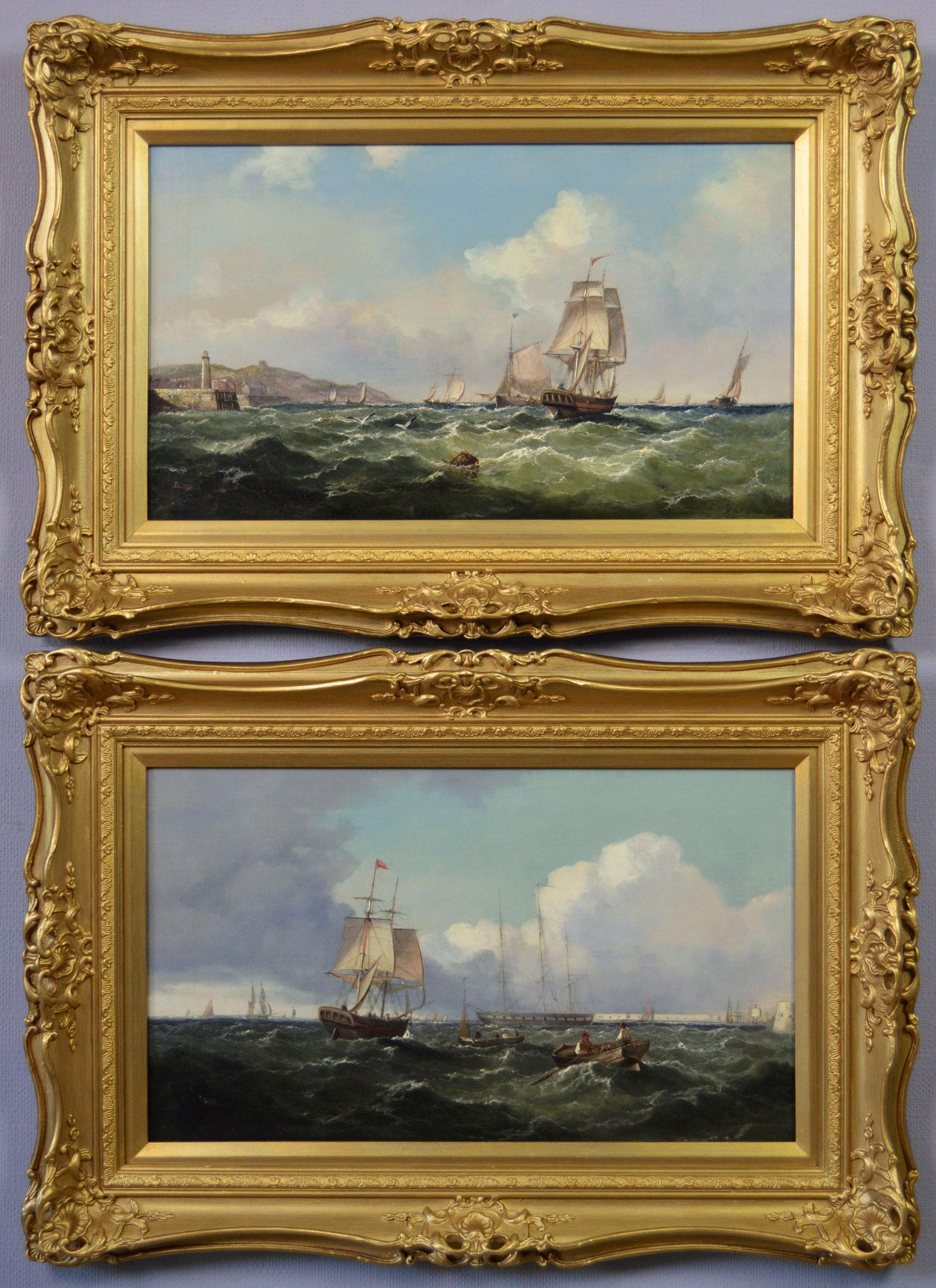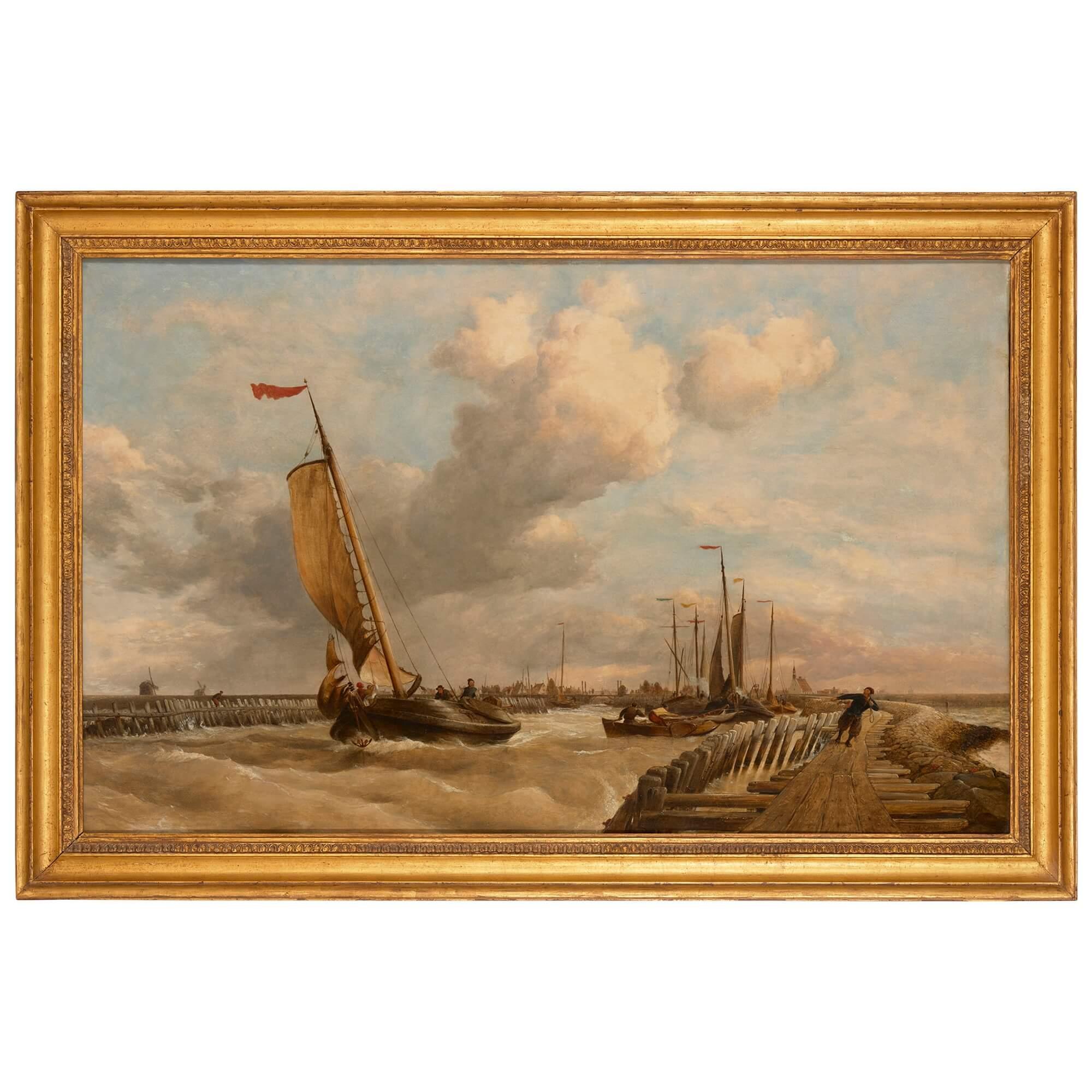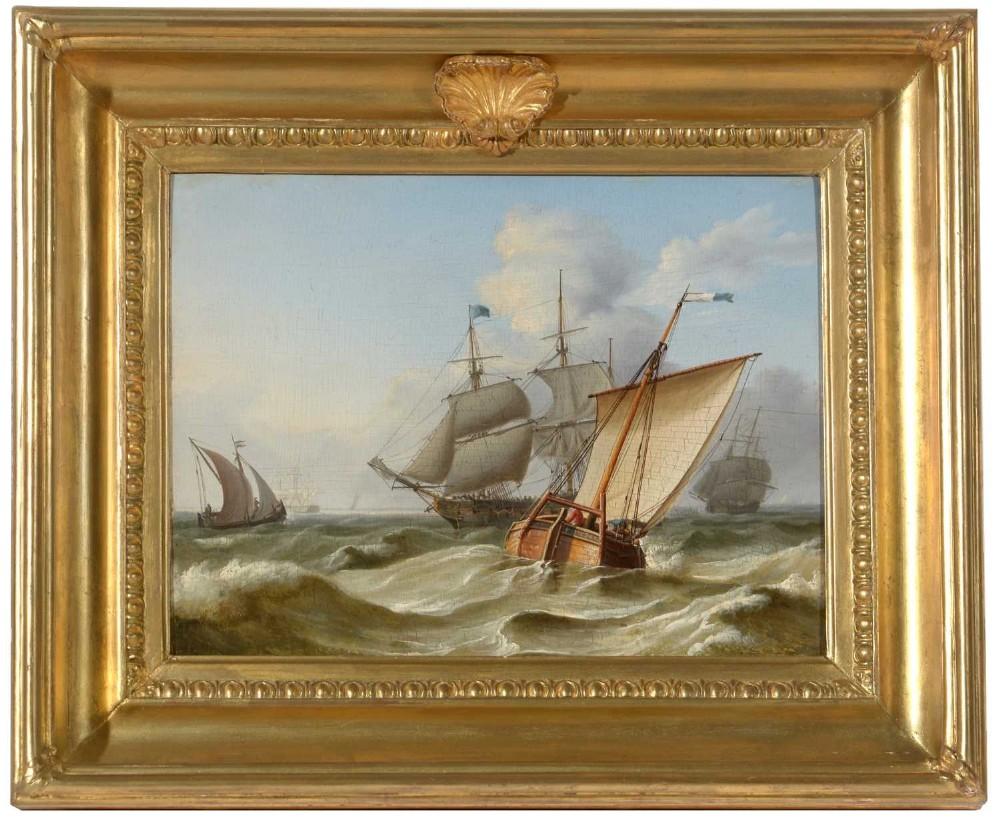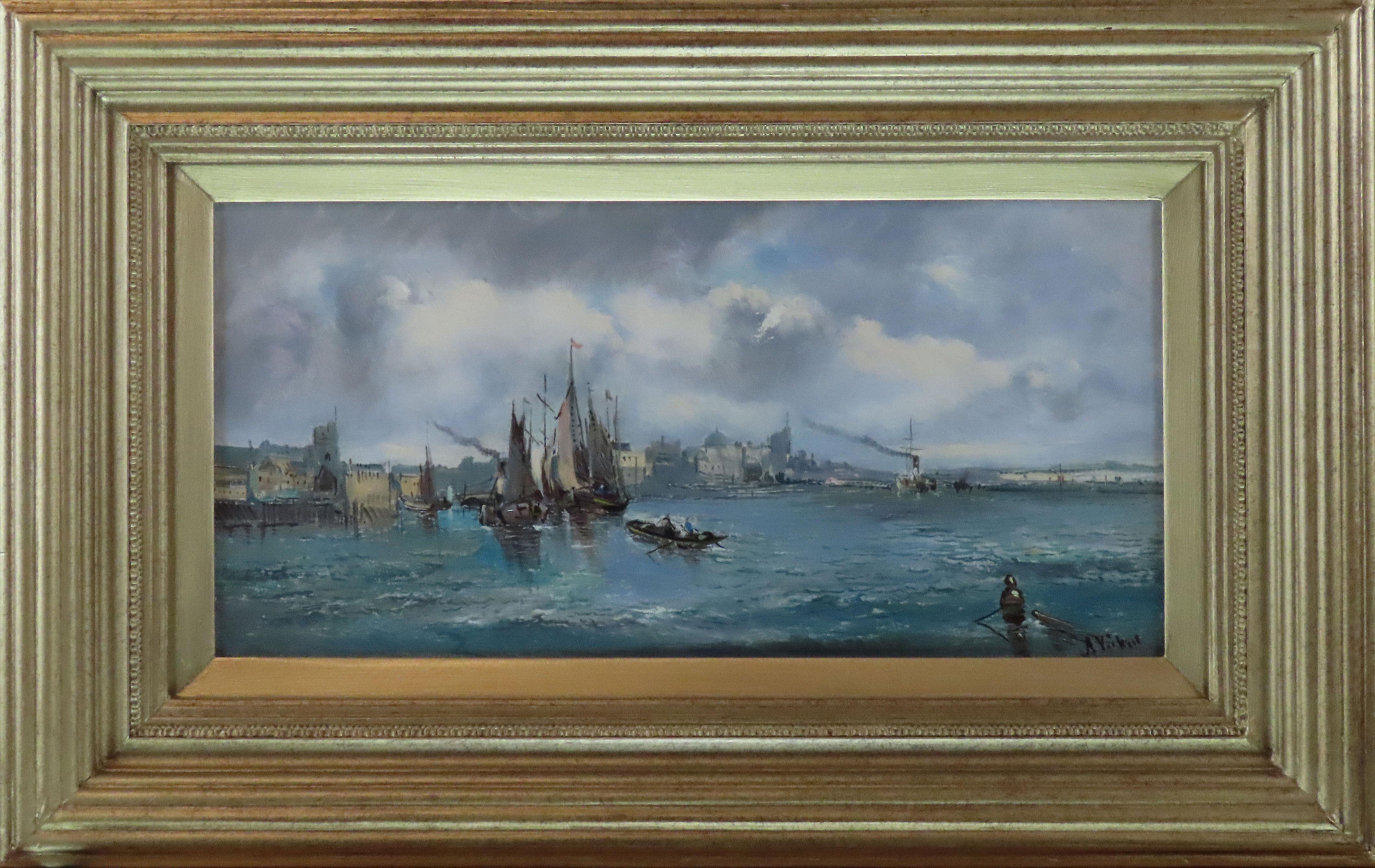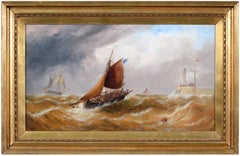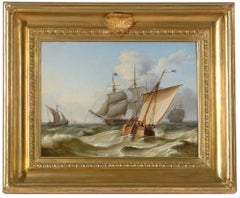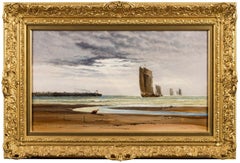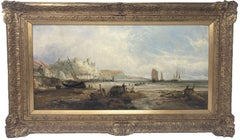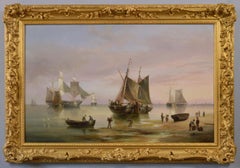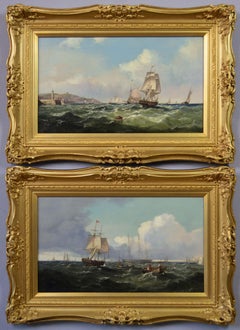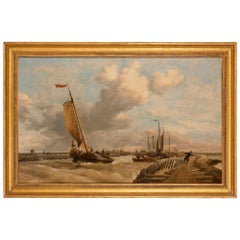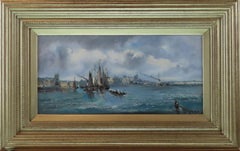Items Similar to Off Portsmouth Harbour 19th century oil , john callow
Want more images or videos?
Request additional images or videos from the seller
1 of 9
John CallowOff Portsmouth Harbour 19th century oil , john callow1844
1844
$6,132.06
£4,500
€5,303.70
CA$8,439.46
A$9,406.66
CHF 4,935.35
MX$114,870.65
NOK 62,492.28
SEK 59,064.71
DKK 39,583.86
About the Item
Off Portsmouth Harbour 19th century oil , john callow
A fine 19th century oil on canvas painting "off Portsmouth harbour "
signed and indistinctly dated 1844, the size of the painting being approx. 45 x 80 cm whilst overall size being 100 cm x 64 cm
Housed in a gilt frame. In very good condition Cleaned and lined with some minor stable craquelure
Frame good condition with only a few minor losses which have been gilded over
Portsmouth Harbour is a 1,264.2-hectare biological Site of Special Scientific Interest between Portsmouth and Gosport in Hampshire. It is a Ramsar site and a Special Protection Area.
The mouth of the harbour provides access to the Solent. It is best known as the home of the Royal Navy, HMNB Portsmouth. Because of its strategic location on the south coast of England, protected by the natural defence of the Isle of Wight, it has since the Middle Ages been the home to England's (and later Britain's) navy. The narrow entrance, and the forts surrounding it gave it a considerable advantage of being virtually impregnable to attack from the sea. Before the fortifications were built the French burned Portsmouth in 1338. During the civil war parliamentary forces were able to carry out a successful cutting-out expedition within the harbour and capture the six-gunned Henrietta Marie.
John Callow (1822-1878)
John Callow was taught by his brother, the artist William Callow. He became a member of the New Watercolour Society, and an associate of the Old Watercolour Society. He was junior professor of drawing at the Royal Military College, Addiscombe from 1855 to 1861.He was master of landscape at the Royal Military Academy, Woolwich, 1861–5 and professor at Queen's College, London, 1875-8. He painted marine subjects and landscapes.
His work is on view at many galleries/museums and at Philipps house, Dinton (national trust)
- Creator:John Callow (1822 - 1878)
- Creation Year:1844
- Dimensions:Height: 25.2 in (64 cm)Width: 39.38 in (100 cm)
- Medium:
- Movement & Style:
- Period:
- Condition:
- Gallery Location:York, GB
- Reference Number:1stDibs: LU1800216048742
About the Seller
5.0
Vetted Professional Seller
Every seller passes strict standards for authenticity and reliability
Established in 1991
1stDibs seller since 2022
23 sales on 1stDibs
- ShippingRetrieving quote...Shipping from: York, United Kingdom
- Return Policy
Authenticity Guarantee
In the unlikely event there’s an issue with an item’s authenticity, contact us within 1 year for a full refund. DetailsMoney-Back Guarantee
If your item is not as described, is damaged in transit, or does not arrive, contact us within 7 days for a full refund. Details24-Hour Cancellation
You have a 24-hour grace period in which to reconsider your purchase, with no questions asked.Vetted Professional Sellers
Our world-class sellers must adhere to strict standards for service and quality, maintaining the integrity of our listings.Price-Match Guarantee
If you find that a seller listed the same item for a lower price elsewhere, we’ll match it.Trusted Global Delivery
Our best-in-class carrier network provides specialized shipping options worldwide, including custom delivery.More From This Seller
View AllSouth Pier, Sunderland 19th century oil , john callow
By John Callow
Located in York, GB
A fine 19th century oil on canvas painting "South Pier, Sunderland "
signed and indistinctly dated 1844, the size of the painting being approx. 45 x 80 cm whilst overall size bei...
Category
1840s Old Masters Landscape Paintings
Materials
Oil
19th Century Seascape, Shipping Off The Dutch Coast, Charles Martin Powell
By Charles Martin Powell
Located in York, GB
A fine painting by Charles martin Powell , The scene depicting shipping off the Dutch coast
This is an oil on panel, the size of the image being ...
Category
19th Century Dutch School Landscape Paintings
Materials
Oil
Arthur Joseph Meadows 19th Century Seascape Off Calais
By Arthur Joseph Meadows
Located in York, GB
A very fine painting by the renowned seascape painter Arthur Joseph Meadows,Off Calais; fishing fleet returning at low tide.
Housed in an antique style gilt frame the size overall is...
Category
19th Century Old Masters Landscape Paintings
Materials
Oil
$8,170 Sale Price
25% Off
Free Shipping
Hastings Castle oil painting seascape 19th century, William Edward Webb
By William Edward Webb
Located in York, GB
Hastings Castle from the beach oil William Edward Webb
A fine 19th century oil on canvas painting depicting Hastings Castle from the beach with fishermen and boats
housed in a git ...
Category
19th Century Old Masters Landscape Paintings
Materials
Oil
19th century oil Devon coastal scene William Shayer Snr (Circle of)
By WILLIAM SHAYER SENIOR (1787-1879)
Located in York, GB
19th century oil Devon coastal scene William Shayer Snr (Circle of)
A very attractive oil on canvas of cockle gatherers on the Devon coast
The painting depicts a busy scene with people gathering their cockles with horses/donkeys laden with baskets ready to take to market.
The painting Bears signature, also inscribed and dated 1833 (lower right)
The size overall is 95 x 130cm whilst the image is 64 x 104cm (25 x 40¾ in.)
Housed in the original heavy gilt frame
Provenance: The property of a lady and gentleman , removed from a Cheshire country house
William Shayer (1787–1879) was an English landscape painter and figure painter who became prominent during the Victorian era.
A self-taught artist, who began by painting decorations on rush-bottom chairs. He moved on to painting carriages in the town of Guildford, after which he started doing heraldic painting...
Category
19th Century Old Masters Figurative Paintings
Materials
Oil
$3,810 Sale Price
20% Off
Free Shipping
19th century oil, view London, the Thames, houses parliament, Francis Maltino
Located in York, GB
A fine pair of oil paintings, oil on board depicting views of the Thames one showing houses of parliament the other barges in busy shipping lane.
Framed and Glazed the size being 26 ...
Category
19th Century Old Masters Landscape Paintings
Materials
Oil
$4,905 Sale Price
20% Off
Free Shipping
You May Also Like
19th Century seascape oil painting of ships on the Humber Estuary
Located in Nr Broadway, Worcestershire
Henry Redmore
British, (1820-1887)
Trading Schooners & Dutch Luggers on the Humber Estuary
Oil on canvas, signed & dated 1873
Image size: 23.5 inches x 37.5 inches
Size including frame: 31.25 inches x 45.25 inches
An atmospheric seascape of fishing boats and ships on the Humber Estuary at sunset. Fishermen can be seen unloading their catch by the shore as others take down their sails and drop anchor.
Henry Redmore was born in Kingston upon Hull, Yorkshire in 1820 to James Redmore and Mary Wilkinson. His father was an engineer and initially Henry followed in his footsteps becoming a marine engineer. His job took him on several voyages as an engineer, which undoubtedly inspired his future career as an artist.
He married Martha Markham on 28 November, 1844 at Hull and together they settled in Sculcoates, a suburb of Hull, They went on to have 4 children...
Category
19th Century Victorian Landscape Paintings
Materials
Canvas, Oil
19th Century pair of marine oil paintings of ships off Scarborough & Portsmouth
By John James Wilson
Located in Nr Broadway, Worcestershire
**PLEASE NOTE: EACH PAINTING INCLUDING THE FRAME MEASURES 18.5 INCHES X 26.5 INCHES**
John James Wilson
British, (1818-1875)
Shipping off Scarborough & Shipping off Portsmouth Harb...
Category
19th Century Landscape Paintings
Materials
Canvas, Oil
Large Victorian coastal marine painting by Edward William Cooke, R.A.
By Edward William Cooke
Located in London, GB
Large Victorian coastal marine painting by Edward William Cooke, R.A.
English, 1842
Frame: height 92cm, width 128cm, depth 6.5cm
Canvas: height 77cm, width 122cm
This superb marine ...
Category
1840s Romantic Landscape Paintings
Materials
Canvas, Oil
Original Oil on Canvas, Alfred Henry Vickers. "Near Harwich"
Located in Mere, GB
Alfred Henry Vickers 1836 - 1919.
Popular painter of rustic and continental landscapes, often on a small scale, grandson of Alfred Vickers senior.
Original frame.
Title inscribed v...
Category
Late 19th Century Landscape Paintings
Materials
Oil
19th century English coastal sea scene with warships, fishing boats and yachts
Located in Woodbury, CT
Alfred Vickers Senior (1786–1868)
Shipping off the Coast, oil on canvas, circa 1860, signed lower left
This lively coastal scene by Alfred Vickers Senior, painted circa 1860, reveal...
Category
1860s Victorian Landscape Paintings
Materials
Oil, Canvas
Grand 19th Century English Marine Painting in Stunning Light
By John Wilson Ewbank
Located in London, GB
John Wilson Ewbank (1799 - 1847)
Shipping in the Harbour, South Shields
Oil on canvas
39.5 x 58 inches unframed
47.75 x 66.5 inches framed
Provenance:
Christie's October 2002; Lot 11.
Fine Art Society;
Private Collection
This marvellous up to scale Ewbank is full of light and warmth and almost certainly his greatest work of the sort rarely - if ever - seen on the market.
John W. Ewbank (4 May 1799–28 November 1847), was an English-born landscape and marine painter largely operational from Scotland.
The Humber river is a large tidal estuary on the east coast of Northern England.
Life
Ewbank was born at Darlington on 4 May 1799, the son of Michael Ewbank, an innkeeper. He was adopted as a child by a wealthy uncle who lived at Wycliffe, on the banks of the River Tees, in the North Riding of Yorkshire. Intended for the Roman Catholic priesthood, he was sent to Ushaw College, from which he absconded.
In 1813 Ewbank was apprenticed to Thomas Coulson, an ornamental painter in Newcastle. In around 1816 he moved with Coulson to Edinburgh, where he had some lessons with Alexander Nasmyth. He found work both as a painter and a teacher. He was nominated in 1830 one of the foundation members of the Royal Scottish Academy.
In 1833 he is listed as living at 7 Union Street on the eastern fringe of the New Town in Edinburgh.
Works
His sketches from nature were especially admired, and a series of 51 drawings of Edinburgh by him were engraved by W. H. Lizars for James Browne's Picturesque Views of Edinburgh (1825). He also made a reputation with cabinet pictures of banks of rivers, coast scenes, and marine subjects.
As an illustrator he illustrated some early editions of Scott's Waverley Novels and one edition of Gilbert White...
Category
19th Century Old Masters Figurative Paintings
Materials
Oil
$198,676
Free Shipping
More Ways To Browse
19th Military Painting
19th Century Military Paintings
19th Century Military Oil Paintings
British Military Oil Paintings
William Burn
Royal Navy Oil
Antique Gun Oiler
William Callow
Painting Of Sunbather
Paintings Of Cherry Blossom Trees
Russian Impressionist Snow
Vintage Running Board
Waterloo Painting
Beach Cottage
Oil Painting Neo Impressionist
Oil Painting Orchard
Sea Painting 17th Century
Spanish Mission Painting
